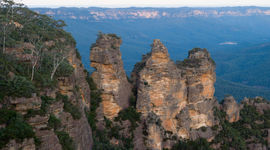.gif)
Three Sisters (Australia)
Encyclopedia

Rock formation
This is a list of rock formations that include isolated, scenic, or spectacular surface rock outcrops. These formations are usually the result of weathering and erosion sculpting the existing rock...
in the Blue Mountains of New South Wales
New South Wales
New South Wales is a state of :Australia, located in the east of the country. It is bordered by Queensland, Victoria and South Australia to the north, south and west respectively. To the east, the state is bordered by the Tasman Sea, which forms part of the Pacific Ocean. New South Wales...
, Australia
Australia
Australia , officially the Commonwealth of Australia, is a country in the Southern Hemisphere comprising the mainland of the Australian continent, the island of Tasmania, and numerous smaller islands in the Indian and Pacific Oceans. It is the world's sixth-largest country by total area...
. They are close to the town of Katoomba
Katoomba, New South Wales
Katoomba is the chief town of the City of Blue Mountains in New South Wales, Australia and the administrative headquarters of Blue Mountains City Council. It is on the Great Western Highway 110 kilometres west of Sydney and 39 kilometres south-east of Lithgow. Katoomba railway station is on the...
and are one of the Blue Mountains' best known sites, towering above the Jamison Valley
Jamison Valley
The Jamison Valley forms part of the Coxs River canyon system in the Blue Mountains of New South Wales, Australia. It is situated approximately 100 kilometres west of Sydney, capital of New South Wales, and a few kilometres south of Katoomba, the main town in the Blue Mountains.-History:The...
. Their names are Meehni (922 m), Wimlah (918 m), and Gunnedoo (906 m).
Geology
The Sisters were formed by erosionErosion
Erosion is when materials are removed from the surface and changed into something else. It only works by hydraulic actions and transport of solids in the natural environment, and leads to the deposition of these materials elsewhere...
. The soft sandstone
Sandstone
Sandstone is a sedimentary rock composed mainly of sand-sized minerals or rock grains.Most sandstone is composed of quartz and/or feldspar because these are the most common minerals in the Earth's crust. Like sand, sandstone may be any colour, but the most common colours are tan, brown, yellow,...
of the Blue Mountains is easily eroded over time by wind, rain and rivers and the cliffs surrounding the Jamison Valley are being slowly broken up.
Aboriginal legends
The commonly told legend of the Three Sisters is that three sisters (Meehni', 'Wimlah' and Gunnedoo') lived in the Jamison Valley as members of the Katoomba tribe). They fell in love with three men from a neighbouring tribe (the Nepean tribe), but marriage was forbidden by tribal law. The brothers were not happy to accept this law and so decided to use force to capture the three sisters causing a major tribal battle. Battle ensued, and the sisters were turned to stone by an elder to protect them, but he was killed in the fighting and no one else could turn them back. This legend is claimed to be an Indigenous AustralianIndigenous Australians
Indigenous Australians are the original inhabitants of the Australian continent and nearby islands. The Aboriginal Indigenous Australians migrated from the Indian continent around 75,000 to 100,000 years ago....
Dreamtime legend.
However, Dr Martin Thomas, in his work "The artificial horizon: imagining the Blue Mountains", clearly shows that the "aboriginal" legend is a fabrication created by a non-Aboriginal local Katoomba, Mel Ward, presumably to add interest to a local landmark. The story originated in the late 1920s or early 1930s and is unknown prior to that date.
The Aboriginal traditional owners, the Gundungurra, have a legend that includes the Sisters rock formation. They are currently developing a website which will include these traditional stories.
The Giant Stairway
From nearby Echo Point, a bushwalking trail leads to the Three Sisters and down to the valley floor via more than 800 well-maintained steel and stone steps called "The Giant Stairway". Then a 1.5-hour walk on The Federal Pass trail leads to the base of Katoomba Falls and the Katoomba Scenic Railway. Walkers who don't wish to climb back to the top can take the Scenic Railway back to civilisation for a fee.External links
- Blue Mountains virtual video tour including the Sisters.
- Gundungurra Blue Mountains Aboriginal traditional owners.
- Blue Mountains aerial video footage of Katoomba around the Three Sisters.
- Panoramic View of the Three Sisters

